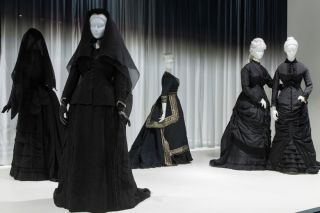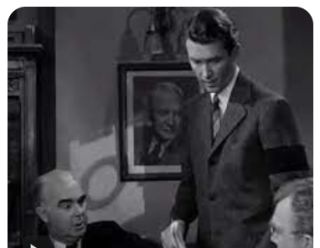Grief
Why Grief Is Ready for Its Renaissance Era
Fashion-forward icons could help bring it back.
Posted September 29, 2023 Reviewed by Gary Drevitch
Key points
- As long as we love, we are going to grieve, and as long as we grieve, we are going to need support.
- Though it was on-trend for half a century, mourning attire has now been out of fashion even longer.
- Black is the customary color of mourning in the U.S., but wearing all black doesn’t infer what it did.

Over the past couple of years, I’ve started paying attention to what others are wearing. More precisely, to what they’re not wearing, and this time of year is especially insightful. On the heels of New York’s Fall Fashion Week, I’m searching for articles written by industry insiders and scrolling socials looking for clues from the runway. So far, the general consensus seems to be that forthcoming fashion trends will feature sequins and sparkles, a “vibrant” lilac color palette, and an overarching nod to nostalgia with a return of ribbons, mod-minis, and 1960s silhouettes.
The trend that I’m scouting was all the rage in the '90s but has yet to make a comeback. Though I’m disappointed, I’m not surprised.
When you think of 1990s fashion, grunge-wear may come to mind. But the look I’m loving reigned a century earlier, in the 1890s, when a trailblazing icon popularized and normalized mourning wear. Though on-trend for over a half-century, it’s now been out of fashion even longer. But in our divisive, war-torn, lonely, post-pandemic world, here’s why we need mourning attire to be on-trend again.
Origin Story
When Queen Victoria of the United Kingdom was widowed, she expressed her grief through mourning attire — an outward expression of grief — and she did so for four decades, until her death in 1901.
Though the symbolic color of grief had long been white, the Queen opted for black. Her wardrobe included ornate gowns and intricate veils, as well as shoes and accessories made from the finest materials. Wearing mourning attire allowed a griever to communicate without saying a word. It conveyed respect for the deceased, expressed the intensity of grief, and also signaled not to expect social engagement. Though the Queen's bespoke black wardrobe was not duplicable, her sentiment was.
On All Days, We Wear Black
European women of high society embraced the Queen's example and their American counterparts soon followed. As these ladies made mourning attire a social requirement, emerging etiquette handbooks outlined the rules: For example, when and how to appropriately incorporate white into one's dress (at half-mourning), acceptable modifications (dark gray or lavender depending on timing), and proper duration (six months for extended kin and up to four years for widows).
In his 1917 paper, "Mourning and Melancholy," Freud opined that mourning was important in helping a griever move forward in life after loss. But a year later, World War I was ending, and with more than 116,000 Americans dead and over 200,000 wounded, mourning attire and its stringent rules were abandoned. A more simple standard took its place: a black armband, typically worn for one year.
By the end of World War II, the armband had faded, and the mourning attire was again reduced, this time to a single color.
Today, black remains the customary garment color of grief and mourning in America. However, wearing all black today doesn’t infer what it once did, making it difficult to discern who in the general population is grieving and who is say, a minimalist, or a restaurant host. Since sporting an all-black outfit no longer alerts others to our grief, it's time to find another way to communicate what we don’t want to say but want others to know. But grieving isn't always activated by physical death, so those experiencing ambiguous grief are welcome, too. And yet participation can't be a societal mandate because how we grieve and (if we) mourn isn’t the same.
There Is No “Correct” Way to Grieve
I’ve learned this firsthand by guiding clients, interviewing grievers, and learning about loss from countless, heartfelt stories. Along with my own grief, bearing witness to others has taught me so much. Learning about mourning wear has, too. While the timebound rules of 19th-century fashion may seem "extra," they were on to something. Perhaps they collectively understood what many of us learn only when it's our turn to outlive the loss of someone we don't know how to live without: Grief doesn't end at the funeral. In fact, it never leaves us – not fully, anyway.

Recently, Barri Leiner Grant, founder of The Memory Circle offered a fitting perspective: “I see grief as something we wear, like a cardigan. Some days it's itchy and uncomfortable, some days we welcome its warmth. Some days it drapes us lightly, and other days it heavily weighs on us. We seek its comfort one day and wish we could take it off the next. But we can’t, so we have to learn to live with it.”
So true.
Grant's cardigan analogy resonates with me and I'm dreaming that one day, real-life "grief-cardis" will be available in stores everywhere. Until then, it seems that a singular homemade adornment might suffice. At the very least, we could appoint a colorful ribbon (a "vibrant" lilac, perhaps?) as the griever’s emblem and simply start wearing them however we’d like. Pin it to your coat, wrap it on your wrist, affix it to your hat, or opt-out altogether, whatever feels right to you. Like the mourning wear of before, the purpose is to visually signal that you are grieving, which, in turn, allows a host of societal norms to be activated — this time, without the cumbersome crinolines and 19th-century mean girl vibes.
Maybe seeing that lilac ribbon would inspire you to offer a kind smile to a stranger or say hello to an acquaintance when you otherwise wouldn’t. Wearing the ribbon may even help quietly explain a griever’s abnormal behavior. While symptoms including forgetfulness, confusion, slow thinking, and fatigue are common in “grief brain," they are easily misinterpreted without context.
Grievers Need a Queen
At a time where we are more technologically connected than ever before, we’re also experiencing an epidemic of loneliness. Recognizing another person’s grief – and allowing our own to be seen – could help. It would also invoke more compassion, encourage patience, and illicit grace. These are kindnesses our society needs, because unlike skinny jeans and bell bottoms, grief isn’t something that will be “in” this season and “out” the next.
If only we had a fashion-forward, trendsetting queen (or two) to rock that cardigan and rally grievers everywhere into a Renaissance Era (wink wink). Until we do, I’ll be searching stores each season, adjusting my invisible perma-sweater daily, and looking for the broken-hearted lilac-colored ribbon wearers among us.
After all, the word from Fashion Week is that ribbons are on-trend.
References




